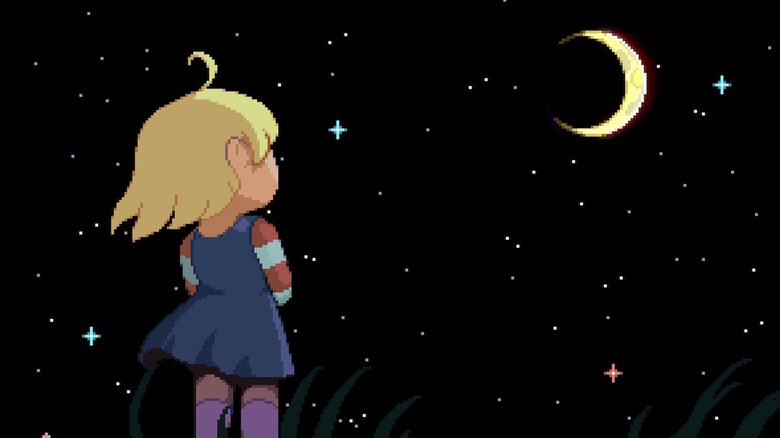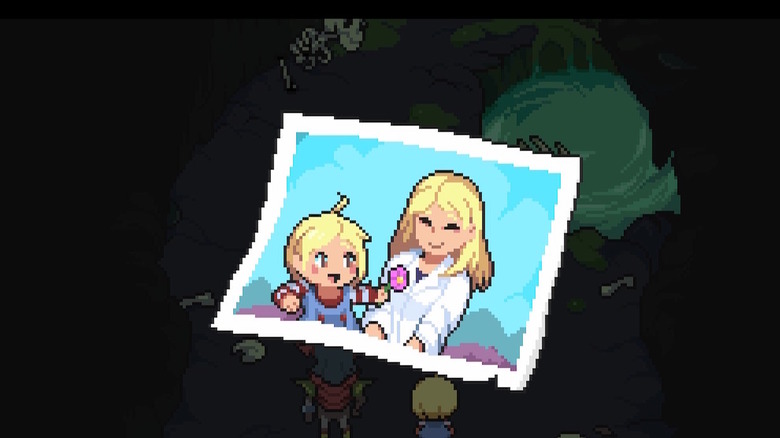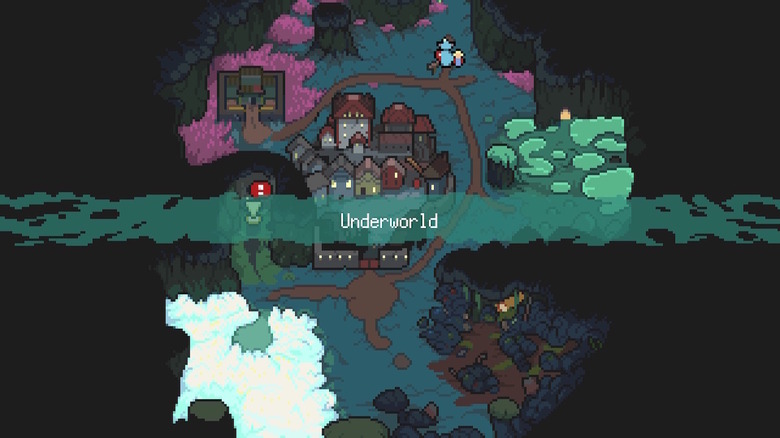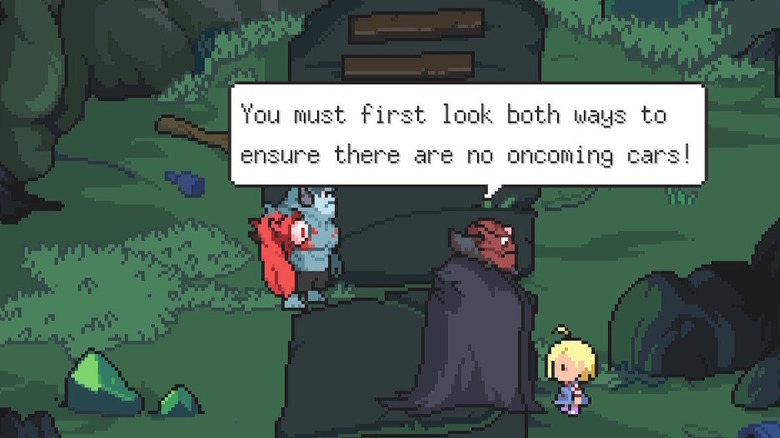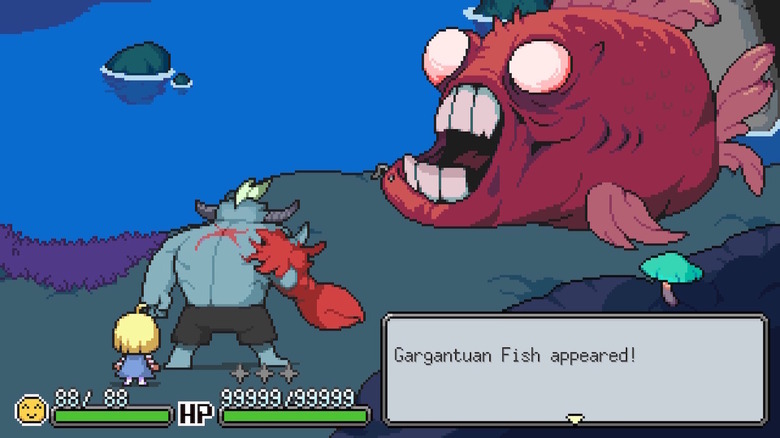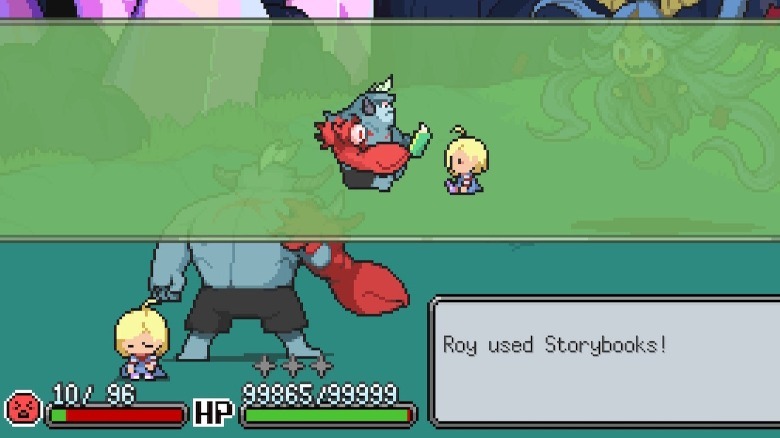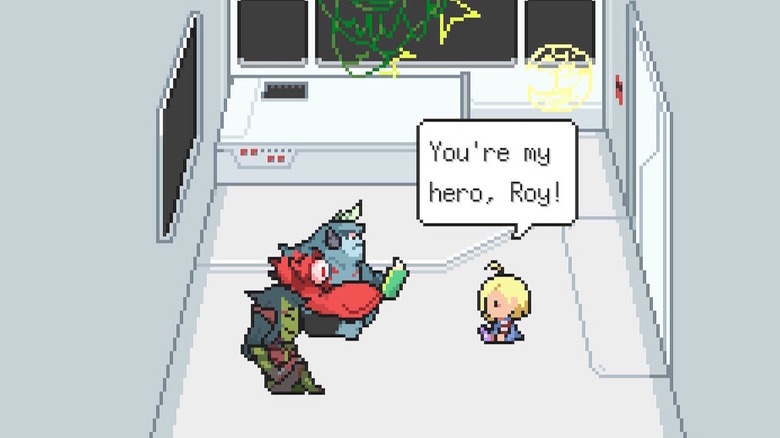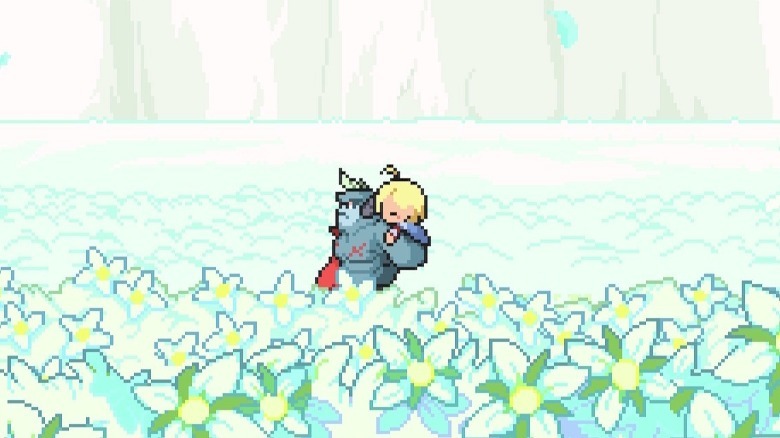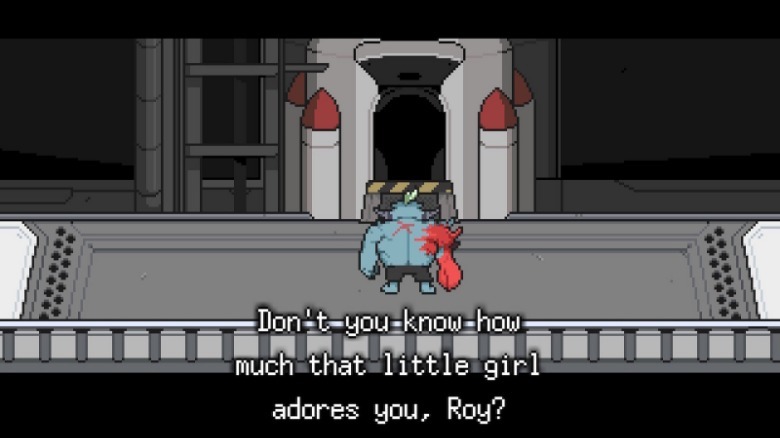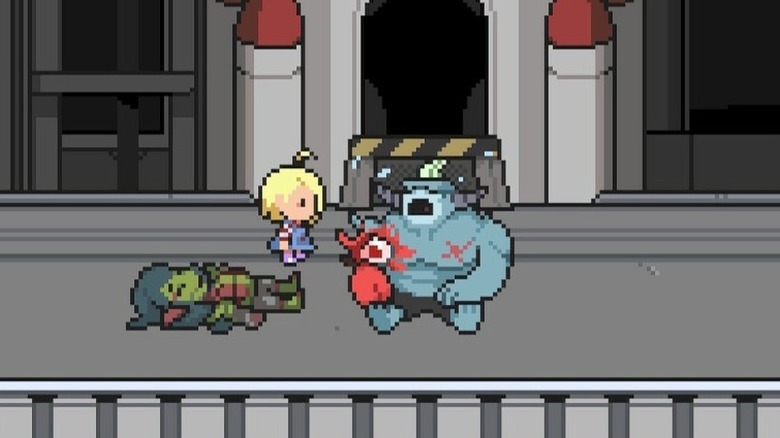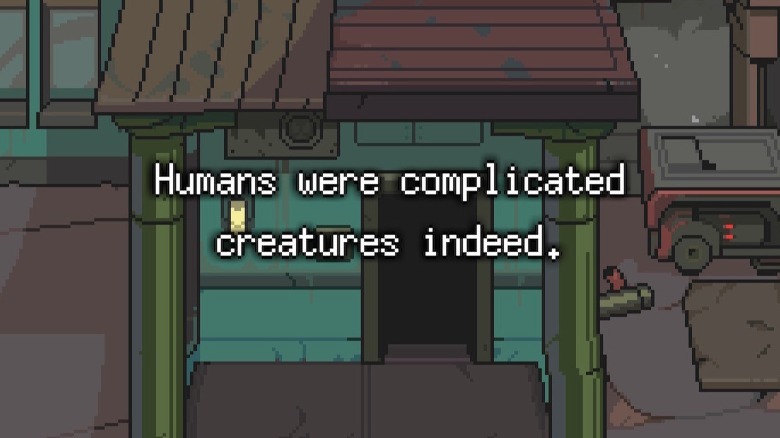Meg's Monster Review: A Heartfelt And Witty Venture On Nintendo Switch
- Thought-provoking and emotional narrative
- Unexpected story developments sweep you along
- Easy-difficulty fighting
- Short, but impactful, gameplay
- A few minor mechanical glitches
- Turn-based games and JRPGs aren't for everyone
I am so glad to see the recent rise of public interest in visual story/visual novel-type video games. There's always been plenty of space for the hunched-over, unblinking, button-mashing games, but I think the mellow titles that want to tell you a story more than put you to the test are appreciated now more than ever. After all, the goal is for the world within the screen to be one we want to escape to ... right? Of course, I only speak for myself, but when it seems like I'm stuck playing real life on hard mode, it's these types of word-weaving games that bring me a reprieve.
"Meg's Monster" was released on March 2 by Odencat, a Japanese game studio specializing in pixel graphics games most known for the titles "Bear's Restaurant" and "Fishing Paradiso." This most recent release is described as an Adventure JRPG; it's a short-run single-player game available for Windows or macOS through Steam, Xbox Series X|S, or Nintendo Switch.
Spoiler alert: Some sections of this review contain spoilers. Odencat provided me with a "Meg's Monster" code for the Nintendo Switch for the purpose of reviewing the game.
"Meg's Monster" is the story of a little girl that finds herself needing the assistance of a couple of monsters in a world where humans are very much on the menu. The catch, these ghouls quickly find out, is that for some reason, when Meg cries, the world begins to heat up, quiver, and flash red — signaling the start of the apocalypse. So our monsters must get the wayfaring child back to safety without her ever shedding a tear.
You might be a little confused at first, but hang in there
The opening to "Meg's Monster" left me feeling a tad lost at first, but I caught on eventually. I knew from the description of the game that the premise is a little girl lost in the dangerous Underworld needs the help of a hulking, grumpy monster to get back to her human world safely and reunited with her mom, who was a scientist in the villainous laboratory in the human world.
The game opens with a blond adult woman wandering through a dilapidated, abandoned lab, reminiscing about things that don't yet make sense. This is a somewhat long opening scene, and because of what little I knew about the game, I assumed this character from the start of the game was the mom. This only furthered my confusion about this abandoned place and the timeline of everything. Why were we seeing the mom right off the bat, and where exactly was the Underworld in relation to humans? Is it beneath the surface, like purgatory? Is it another dimension? Something else entirely? It turned out that the character wasn't Mom at all, but Meg in the present day.
The opening narration could have been a bit better outlined — just making the mom a brunette would have been enough to distinguish the little girl, Meg, as an adult, from her mom's character, or adding some sort of chronological indicator to help orient the player. Or just flat-out telling us would have been good, too. (The game improves at all of this later, though.) On the other hand, I know how compelling yet informative openings can be tough and for players — it's best to just go along with it and have faith that questions will eventually be answered, so I didn't let this faze me too much.
A very small map with linear progression
The "Meg's Monster" map is small. I roughly define it as three major portions — which I'll only say are the Underworld and two others to avoid spoilers. Each of these maps portion has maybe a half-dozen or so points of interest. It's a very classically linear game design; access to different areas is only offered to you when it's in line with the story. You were only able to access one, maybe two locations at a time — which I thought was particularly funny since the game asks you something along the lines of "are you sure you want to go here?" when you select the only port on the map available for travel. Do I have a choice?
Any time there were two ports available, that meant an optional side quest was available. I don't personally like when a game's optional side missions are only temporarily open and disappear forever if you don't engage them within a certain amount of time, but I begrudgingly lament that it makes sense in a game design like this, because quest relevance eventually diminishes as the story progresses.
From opening to credits, moving at a very leisurely pace, and opting into all side quests, I only put just under six hours into the game. Interaction with the environment is pretty limited, but I didn't come into it expecting a whole lot. I will say that the mechanics for lining up your character to interact with something around you and initiate a needed action or dialogue were a bit rough around the edges — often I had to circle a character or object a couple of times while spamming the interact button to line everything up just so. This could be a program unique to the Switch, though.
Immersion into a quirky yet distantly human world
The realm of the Underworld is so enduringly, eccentrically human. Not in a way that implies a lack of imagination or laziness from the designers in drafting a monstrous way of living and thinking. Rather, it's in a clever way that demonstrates that a set of universal truths — whether in the world of monsters or the world of humans — dictates us ... like the importance of teaching children to look both ways for cars before crossing a road. Even if the teacher is a towering, cloaked red monster and the child is the harbinger of ruin. There were a lot of instances like that — Roy being stuck playing horsey was another that stuck out — and they were all insanely cute.
Other human touches are more humorous than they are heartfelt, a cheekiness from Odencat that didn't go unnoticed — like the fact that some monsters have the first names of middle-aged accountants, like Roy and Jason, while others have more fittingly ghoulish names like Golan and Creeper. Along the way, there are many amusing instances where our gruff protagonist encounters unfamiliar tokens from the human world, and the use of written dialogue to show the wonder and curiosity in the unknown world is delightfully adorable — like "foe-toe" and "dee-vee-dee."
The combat was unique and enjoyable to me
JRPG turn-taking-style fighting isn't everyone's cup of tea, but I enjoy it every now and again. There were some unusual components to the fighting in "Meg's Monster" that I was happy to see. For one, Roy's insane HP — 99,999, as you can see — follows the narrative of him being this brutish battleship of a monster that only need worry about taking damage from the strongest of foes. At first I thought this meant that our protagonist wasn't capable of dying, but you quickly realize that his Achilles' heel is the happiness meter of that little girl peeking out from behind him. The more distressed Meg becomes, the closer she gets to crying — and when her heart finally breaks ...
Another really fun element to the fighting was that, with this ticking time bomb and her very short emotional fuse, Roy has the capability to soothe Meg using toys — which are also the only thing you could consider a collectible in this game. Having to strategize and parcel out your turns so that you can also play with Meg and raise her emotional defenses again, in between attacks and guards and the many puzzles you face during combat, added a nice layer of challenge.
Meg's Monster wasn't designed to be difficult
In terms of difficulty, the combat on "Meg's Monster" was not. The toughest part was what's true of any turn-based fighting: Laying out your moves in a way that's offensive but prepares you for the unexpected. There are no surprise battles, nor can you opt out of any. Most combat scenes were clearly orchestrated to progress in certain ways — with Golan dashing in to make Meg laugh and raise her emotional health bar, enemies unexpectedly falling asleep so you can attack them — which I think you could either love or hate depending on how hard you wanted the game to be.
It's in the "Meg's Monster" fight scenes that the true JRPG signature of a game shines through — not only do you have the turn-based play, but there's also a whole lot of DBZ-reminiscent shirtlessness and shredded abdominals (even on old guys and monsters, which made me laugh) and villains that say, verbatim, "mueh-heh-heh-heh." They might as well have been rubbing their hands together evilly or petting a cat — evilly — in each scene, too. It was goofy, but in an endearing way.
What absolutely stood out to me the most about the fighting in "Meg's Monster" was a scene in which Golan and Meg are trying to sway Roy from making a decision, and in doing so, each initiate a battle against him. Odencat uses this as an opportunity to switch our controls suddenly from Roy to first Golan and then Meg. What ensues isn't a fight, though — with Roy's insane HP now turned against you and instead being in the bodies of two much weaker characters, your strategy suddenly becomes using pleas, reasoning, flashbacks, and hits (that are probably desperate swats, more like, since they only do 1 damage to Roy) in an attempt to prevent him from doing something. It was a simple addition, but I found it to be very creative and profound.
Thoughtful dialogue that swept me along every step of the way
The narrative is easily the biggest strength of "Meg's Monster" — and the most prominent feature. I think at least 60% of the six-ish hours I spent playing was spent observing dialogue scenes. The scope of the narration is really impressive; the heart, sense of humor, and emotions in each main character is distinct and interesting. Odencat's team clearly had a lot of attention and effort put into the development not only of the interpersonal relationships — main protagonist Roy and his best pal Golan even share a lot of dudes, bros, and other general buddy-buddy quips and back-and-forths — but also the development of each character as the game progressed. The insight into fear, anguish, and regret shared in this dialogue is what made "Meg's Monster" as impactful as it was.
There were only a few times when I had the freedom to choose what was said next, and those instances didn't seem to have any impact on the story progression or different versions of dialogue. Surprisingly, I was happy to relinquish most of the control in this game's narrative — I was fully sold on the story being told to me. The most dynamic characters in "Meg's Monster" are very clearly the main three — that's Meg, Roy, and Golan — but there was still a lot of pleasant backstory and quips of humor to be gleaned from other supporting characters.
Roy's awakening: The big twist and a second ending
You reach a false end of sorts during the game, and that resolution will devastate you — in such a short time, I had gotten so attached to this little trio that the tragedy of that ending brought tears to my eyes. If you play "Meg's Monster" and find yourself feeling a bit cheated with that ending when the story is (seemingly) over and the credits appear to have started rolling, just hang on. The game finds its stride and surges forward into an unexpected new chapter, where we take on a more omnipresent stance and get unexpected insight into the motives of many other characters.
One disclaimer is that at this point right before that new chapter, Meg is tasked with making a major choice. I don't know if the decision I made impacted the direction the rest of the game went — the other choice could have ended the game right then and there, for all I know.
Once I finally reached the actual end of "Meg's Monster," I was infinitely more approving of the true resolution — it brought a silver lining of hope for the fate of these fictional creatures that softened the sadness remaining even in Roy and Meg's final chapter. As Roy grows begrudgingly fond of Meg and his stony countenance melts, I was reminded of the warm and fuzzies bestowed by a certain beloved childhood Pixar movie that also follows a lost young girl, a big ole grump of a monster, and his more sociable best friend — "Meg's Monster," like that movie, was discreetly-packaged wholesomeness and tribute to human nature under the guise of colorful pixelated monsters.
A lot of the major revelations in "Meg's Monster" have to do with humans mistreating each other and the environment around them — so it's easy to glean that some deeper themes are at play. When the game's plot reached its peak, we were shown both how kind and selfless those we perceive as monsters can be, and what ugliness humans are capable of. It felt clear that this was what Odencat meant to do — to invoke emotion, tug at heartstrings, and leave you staring at the credits with hope and hopelessness dueling inside the mind.
Spoiler Alert: The one plot hole that left me unsatisfied
There's one thing that was not explained in "Meg's Monster" that I believe really should have been addressed. By the time I reached the end of the game, I was so taken aback to realize that this wasn't covered in the storyline that I started a second play-through just to make sure I hadn't missed anything. But at the end of it all, when the credits rolled, one major question was still unanswered to me: Why, exactly, did Meg fall into the chasm that led to the Underworld?
We know that it was Mom who fell in before Meg, and Mom somehow escaped the Underworld, and we understand at the end that it was ... something to do with the lab that the mom worked at that caused Meg to fall in. Did Meg go looking for Mom (and figure that the huge hole in the ground was a good place to start) then slip and fall in? But if both Meg and Mom fell down the same shaft, wouldn't they have landed in the same place and never been separated in the first place?
It left me frustrated to not understand this, but I suppose I'll never know the answer to those questions unless I turn up more subtle queues during my second play-through.
Is 'Meg's Monster' worth the buy?
Yes. Yes, I think you should pay the asking price, (less than $20) to play "Meg's Monster" next time you have a long, uninterrupted weekend afternoon to fill. The quirks about the mechanics that I didn't care for aside, this is the most impactful that a game has been on me in a long time. Odencat is owed major props for being able to pull us through such a broad spectrum of emotions — anger, curiosity, amusement, sadness, and joy — in such a short length of time.
Had I purchased "Meg's Monster" for myself, it probably would still have been a one-and-done play-through for me — except maybe to seek an answer to that plot hole — but even a game without much repeat-play value can still be a really fantastic game. Even if JRPGs aren't your thing, even if you never could get into turn-based fighting — don't look at "Meg's Monster" in that way. Look at it as a game with a story to tell, with you being the perfect audience — especially if you've never learned that it's okay to be vulnerable.
